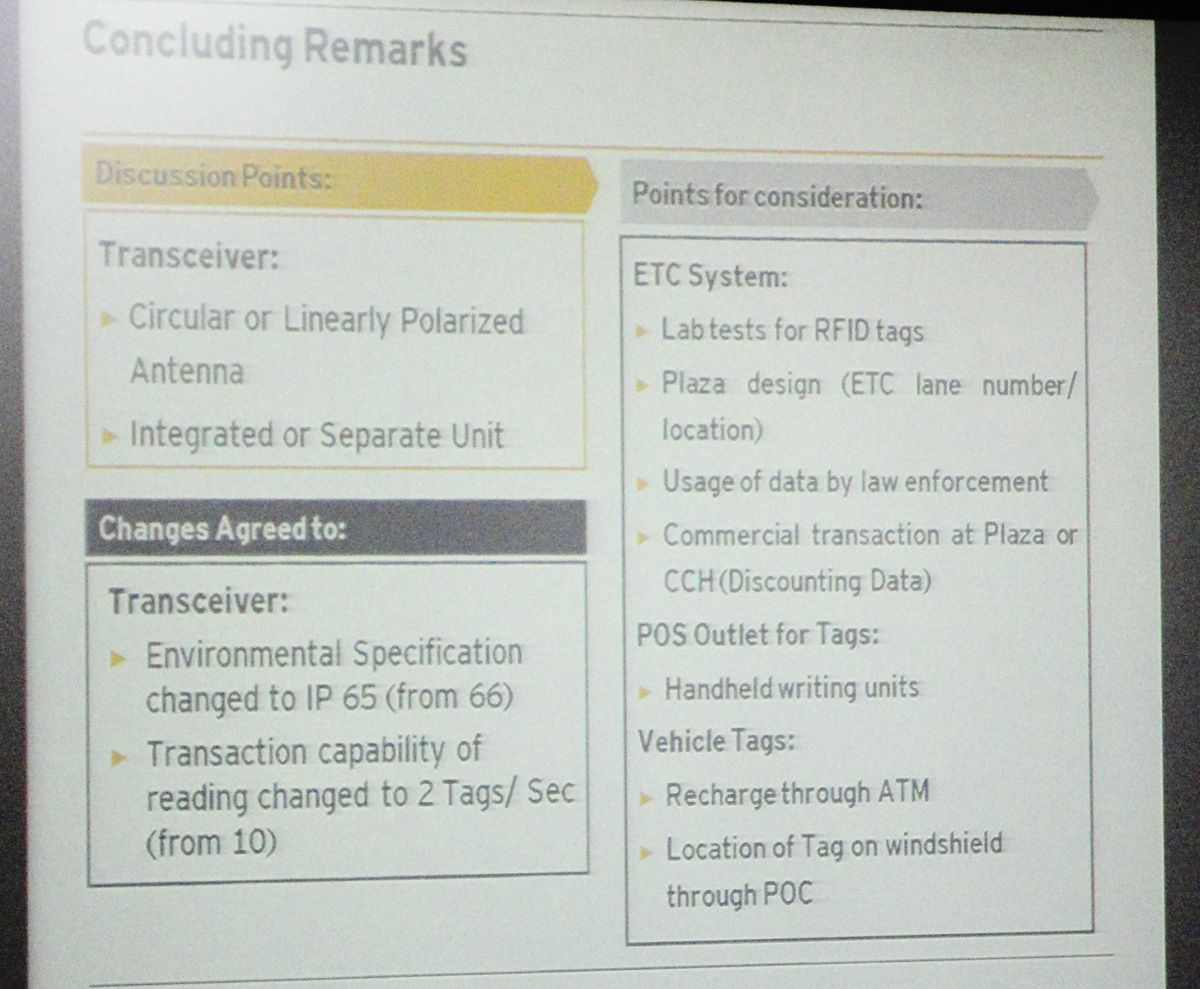Quit Toll Day on August 9
August 18, 2011
KOCHI: After a short interval, the days of agitation are back at Kumbalam Toll Plaza. With the National Highway Authority of India (NHAI) resuming toll collection, various organisations under the aegis of National Highway Protection Council have commenced an indefinite strike to protest against toll collection along the Aroor-Edappally stretch of NH 47.
On August 9, Quit India Day, the agitators will observe the day as Quit Toll Day. “We have decided to organise an indefinite strike. Today we erected the pole for constructing a tent for the strike near the toll plaza in Kumbalam,” said C R Neelakantan, activist and leader of National Highway Protection Council (NHPC). “People who pay heavy road taxes are being forced to bear the additional burden of toll which is unfair. Our demand is that the Government should construct 30-metre wide NHs. There is no need to construct the 45-metre-wide road,” he said.
“Construction of private NHs or BOT-based NHs are not feasible in the state. Unlike other states where NHs are used by long-distance travellers, here short-distance travellers constitute the major chunk NH users and it is difficult for them to pay toll every day,” Neelakantan said.
Many organisations have already come forward to conduct the strike every day till August 15. “August 15 will be observed as the Right to Travel day. We plan to picket the toll plaza.
We are yet to give shape to the programme,” Neelakantan said. In other states, few roads cut the across NH and that too after 40-50 km interval. But in Kerala, on an average of more than five roads will enter the NH on a one-km stretch. So, it will be very difficult for the locals to pay the toll,” he said. The NHPC argues that elevated roads can be constructed using the subsidy given for BOT roads and the amount used for acquiring land for the widening the road.
Source: http://expressbuzz.com
Workshop on Nationwide Electronic Toll Collection, held at Vigyan Bhawan, New Delhi on June 14, 2011
June 15, 2011
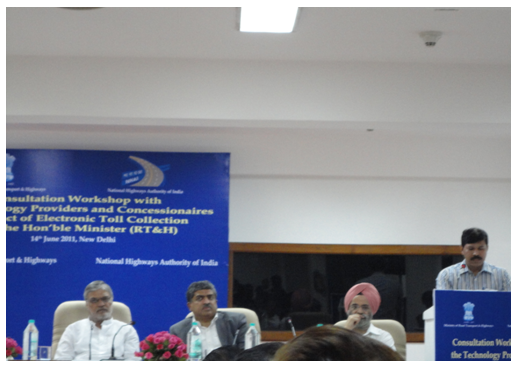
Workshop on Nationwide Electronic Toll Collection
- Mr. C P Joshi , Honrable Minister Road Transport and Highways
- Mr. Nandan Nilkani , Chairman , UIDAI
- Mr. R S GUJRAL , Chairman NHAI
- Mr. Ravi Palekar , GM (Electronics) , NHAI – Addressing the gathering
- Mr. Sachin Bhatia, CEO, Metro Infrasys
Workshop on Nationwide Electronic Toll Collection held at Vigyan Bhawan, New Delhi. With an objective of paving way for a unified Electronic Toll Collection (ETC) technology for National Highways in India, the Ministry of Road Transport & Highways constituted a Committee under the chairmanship of Shri Nandan Nilekani Chairman of UIDAI with a mandate to examine all technologies available for Electronic Toll Collection (ETC) and recommend the most suitable one for implementation throughout India. The other members of the Committee are Prof. Pankaj Jalote, Director, IIIT-Delhi ; Dr. Kolin Paul, Asst. Professor, IIT-Delhi ; Shri A.V. Sinha, DG (Road Development) & Special Secretary, MoRT&H and Shri. V.L. Patankar, Member (Technical), NHAI (Member Secretary).
The Union Minister for Road Transport & Highways Dr. C.P. Joshi has said that we should chalk out a plan to increase the percentage of national highways from present 2.2 % to 5 % in the next 10 years. Delivering inaugural address at the Consultation Workshop with the Technology Providers and Concessionaires in respect of Electronic Toll Collection (ETC) here today, he said that keeping in view the various types of highways there should be a hybrid pattern of toll collection. The Workshop was jointly organized by Ministry of Road Transport & Highways, National Highways Authority of India & National Informatics Centre. The Chairman of UIDAI Shri Nandan Nilkeni & Minister of State for RT&H Shri Tusharbhai A. Chaudhary also addressed the workshop. Shri R.S. Gujral, Secretary Ministry of Road Transport & Highways and Dr. V.K. Gairola, D.G (NIC) were present.
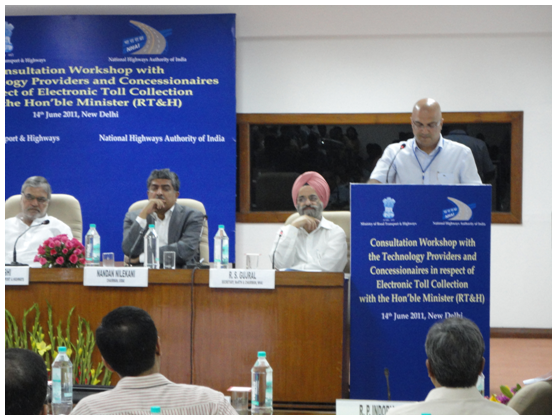
Mr. Sachin Bhatia CEO Metro Infrasys expressing the support from Industry Fraternity
Based on the recommendations of the committee headed by Mr. Nandan Nilekani to use RFID technology for ETC, the Apex Committee, responsible for ETC implementation planning, is in the process of prescribing certain standards which should be complied with all over the country to ensure interoperability. The primary purpose of this workshop was to take feedback from the key stakeholders, comprising concessionaires and ETC technology service providers. Security, cost effectiveness, convenience and scalability have been the main criteria based on which the detailing has been done.
Based on the feedback, the specifications and data detailing will be finalized for open market release. The plan is that the authorized manufacturers will be producing Transceivers and Tags based on these standards, the concessionaires will be procuring these Transceivers and in turn, the technology service providers will be integrating the entire ETC system at the toll plaza. Although details on other aspects like clearing house are being worked out simultaneously, majority of the decisions will depend upon these standards only.
Followings are the Tolling Companies, RFID Manufacturer and concessionaire took part in the workshop:
- Kapsch Metro
- Egis Infra
- L&T Infra
- GMR
- HCC Infrastructure
- JICA
- IRDSA
- DSC
- EFKON India
- Siemens
- IAITO Infotech Pvt. Ltd.
- ESSEN, Mumbai
- ATT System, Banglore
- Mitsubishi
- IBI Group
- Neology
- Steria
- Tag Factory
Brief of discussion over finalization of technology between committee and Industry Peoples:
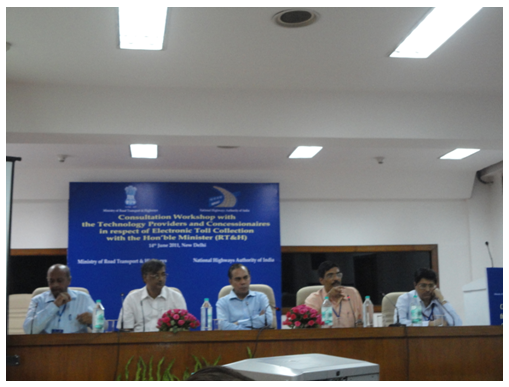
- Dr. B.K. Gairola, Director General, NIC – extreme left
- Dr. Y.K. Sharma, DDG, NIC - middle position
- Dr. Rajat Moona, Director General of CDAC, IIT Kanpur
- Dr. Y.K. Sharma, DDG, NIC - extreme Right
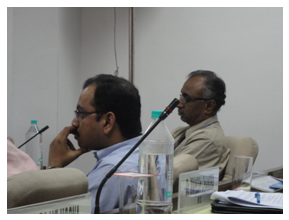 Mr. Venkat from GMR expressed change from IP 66 to IP 65 for the readers as IP 65 is also good enough and IP 66 will increase the cost for the readers without any additional value.
Mr. Venkat from GMR expressed change from IP 66 to IP 65 for the readers as IP 65 is also good enough and IP 66 will increase the cost for the readers without any additional value.
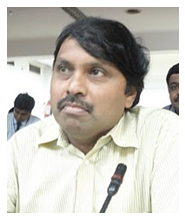 Mr. Hari from Efkon
Mr. Hari from Efkon
He raised an issue over the relative humidity of 100% for Transceiver antenna.
Committee Conclusion :
Committee agreed for the IP 65 standard and 95% relative humidity as it comply against all possible environmental threat at toll scenario.
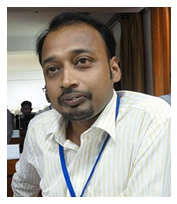 Mr. Anand Shenoy from IAITO Infotech Pvt. Ltd.
Mr. Anand Shenoy from IAITO Infotech Pvt. Ltd.
Raised his voice over minimum requirement of reading of 10 Tags per second with 240 bits of EPC memory and 64 bits of Tag Id.
Committee Conclusion: committee agreed onto change it to 2 Tags per second with above said minimum requirement. On the other query raised by Mr. Shenoy that the data retention period must be 3-4 year for the tag memory instead of 10 years as their is no UV protection asked for the tag and without any special material with the effect of UV rays its hard to maintain the data in tag for 10 years, The committee replied as they will keep it under consideration and if required they will bring it in next phase.
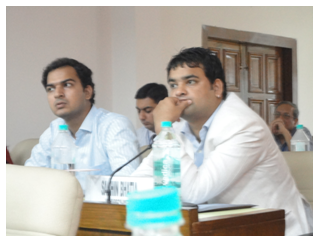 On the query raised by Team from Metro Infrasys- Mr. Nitin Thakur and Mr. Harimohan for the option of having color coded Tags for different class of vehicles, as it will help in operation at toll plazas. The Committee said that it is difficult to see the color in the moving car in the sun. However committee will discuss it in next phase.
On the query raised by Team from Metro Infrasys- Mr. Nitin Thakur and Mr. Harimohan for the option of having color coded Tags for different class of vehicles, as it will help in operation at toll plazas. The Committee said that it is difficult to see the color in the moving car in the sun. However committee will discuss it in next phase.
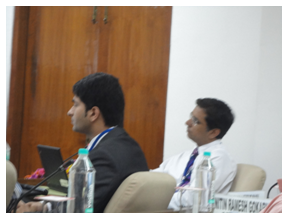 Mr. Vipul Sharma(Left), Mr. Mayank Manish(Right)
Mr. Vipul Sharma(Left), Mr. Mayank Manish(Right)
The long discussed topic was the polarization standard for the antenna, Panel has asked for circular polarization pattern for the antenna but Mr. Vipul Sharma and Mayank Manish from one of the leading manufacturer of RFID Equipment Neology reasoned to have it linearly polarized due to its long range and less interference phenomenon, also linearly polarized antennas can work at higher speed , committee keep this for discussion and will revert again.
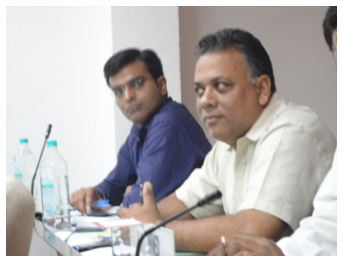 Mr. Manoj Agarwal and Mr. Manish from Delhi Gurgaon Expressway strongly supported the idea of a law for putting a penalty on cash vehicles coming to Tag lane .
Mr. Manoj Agarwal and Mr. Manish from Delhi Gurgaon Expressway strongly supported the idea of a law for putting a penalty on cash vehicles coming to Tag lane .
For the standard for the communication between plaza server and CCH server, there will be addition of Plaza id into the prescribed format by the committee. Plaza level fare plan and policy will be governed by the plaza itself while the global discount will be governed by the CCH server and will be updated in all the plaza server by CCH server itself. Committee also agreed to look into the various aspects of fare plans at different plazas.
Highlights of the Workshop:
ETC critical components:
Tag Distribution Channel & Inventory Management
- On-line channels by user
- Authorized service centers of vehicles (Service centre need to install the SPV client software and antenna connection), since centre must have authorized people to affix tags.
- RTO(Operation is similar to above)
- Vehicle dealer network(Operation is similar to above)
- Authorized point of sale installation(POS can be insurance companies, PUC centers, Petrol Pumps etc; Operation is similar to above)
Inventory Management of Tags:
SPV will keep track of allocated EPC Ids, Tag Ids etc. It will perform a demand forecast Tags and keep the tags available for distribution through distribution channel.
Handling Special Cases
- Valid ETC enabled vehicle was ejected due to non-read of Tag – Premium cash lane should verify it with the ETC database.
- Clone Tag – If customer complains/suspects that his/her Tag is cloned, Tag re-initiation is to be done for same Tag. Old Tag value is marked for special handling.
- Change in registration number of vehicle – Vehicle should approach distribution channel network and get a new tag. Old tag is to be destroyed physically and listed for special handling.
- De-registration of vehicle (due to destruction/ end of life/ Export etc.)-Tag is to be destroyed physically and listed for special handling.
Listing for Special Attention
Vehicle is listed for special attention following conditions:
- Insufficient balance as determined by clearing house
- Credit card co. declined the payment
- On Police look-out
- Suspected cloned Tag
- Tag with invalid Vehicle Registration no. (e.g. when Registration no. is changed)
- When toll plaza operator notices Tag carrying details different from vehicle itself (e.g. the vehicle Registration no. and/ or Vehicle class)
Videos
Conclusions drawn at the end of the seminar:
Documents Attached:
- Agenda Workshop
- Apex Committee for ETC Implementations – GOI, Draft Specifications Document
- ETC Report on RFID – July 2010
 This story is covered by Mr. Sachin Bhatia.
This story is covered by Mr. Sachin Bhatia.
NHAI forced to stop toll collection at Kumbalam
June 13, 2011
KOCHI: Amidst strong protests from the local people and other organisations, the National Highways Authority of India (NHAI) had to stop the toll collection at the Kumbalam Toll Plaza on NH-47, on Saturday.
Following protests, the authorities have decided to convene a meeting of ministers, MLAs and the representatives of various organisations on Sunday to discuss the issue. Activists of various political parties and organisations, under the aegis of the National Highway Protection Council, took out marches to the Toll Plaza at Kumbalam on Saturday morning. Some of them picketed the toll booth.
The agitators and the local people tore away the flex board put up by the NHAI displaying the toll rates.
The agitators prevented the motorists from paying the toll. As the protests grew, the officials closed the toll counters for the day.
Now, Pay Toll By Prepaid Card
March 25, 2011
Pune: Regular commuters on highways will soon heave a sigh of relief, with not having to spend long time at toll booths, particularly during the peak hours, as the Public Works Department (PWD) will soon introduce the concept of electronic prepaid cards, which will enable the vehicles a smooth passage through dedicated lanes.
‘Mahapass,’ the prepaid cards, will be similar to the mobile rechargeable cards, which will facilitate the vehicles to cross the toll booths without stopping while passing through dedicated lanes and simultaneously, the requisite toll being deducted.
With the tenders having already been floated, the PWD will soon launch a pilot project on the Pune-Ahmednagar-Aurangabad-Jalna state highway by May this year through private parties, Subhash Thorave, an official from PWD, told Sakàl Times. After the success of the pilot project, the facility will be expanded on other highways.
There are seven toll booths between Pune and Jalna, and each booth has different toll charges. Whatever be the amount fixed at these booths, it would be deducted from the Mahapass cards, Thorave said. The general experience is vehicle owners get irritated at these toll booths because of clearance time of anywhere between two to 15 minutes, depending on the rush.
Onwards vehicles will not need to pay the cash on toll booths as Public Works Department (PWD) is planning to introduce the prepaid cards for paying the toll on these booths. These card holders will get dedicated lane on toll booth to pass directly and will not need to stop on toll booths. The required amount will be automatically deducted from the card once the vehicle will pass through the toll booth.
This prepaid card will be known as Mahapass and it is same like mobile recharge card. Citizens can recharge it anywhere. PWD is implementing the pilot project on Pune-Ahmednagar-Aurangabad-Jalna stretch.
MAHAPASS SCHEME
‘Mahapass,’ the prepaid cards, will be similar to the mobile rechargeable cards, which will facilitate the vehicles to cross the toll booths without stopping while passing through dedicated lanes.
Delhi-Gurgaon Expressway: Job Unfinished
November 16, 2010
 These days driving on the Delhi Gurgaon Expressway in Peak Hours, perhaps you are asking yourself, what must be the traffic condition at toll plaza and at entry road to my office? How much time is needed? Will the traffic move fast or slow? It’s been more than 2 years since the highway became operational but the degree of difficulty in driving on this has increased sharply in recent months as more and more sections are
These days driving on the Delhi Gurgaon Expressway in Peak Hours, perhaps you are asking yourself, what must be the traffic condition at toll plaza and at entry road to my office? How much time is needed? Will the traffic move fast or slow? It’s been more than 2 years since the highway became operational but the degree of difficulty in driving on this has increased sharply in recent months as more and more sections are
becoming congested.
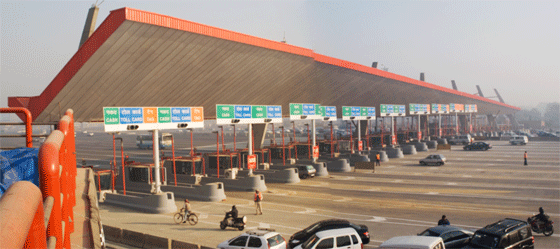
When Delhi Gurgaon Expressway was conceived by NHAI, the main objective was to provide high-speed connectivity between Delhi and the commercial hub, Gurgaon. However, today instead of providing speed connectivity it has become a subject of argument between, NHAI, Concessionaire and planning authorities of Haryana and New Delhi.
January 2008 marked the completion of the much-awaited Delhi Gurgaon Expressway but due to lack of proper planning, poor traffic forecasting, unplanned traffic management, poor urban design and lack of traffic enforcement it became a nightmare for the users. Further the increased traffic added to the mess in management of the highway and concessioner faced a huge challenge in starting the operations.
It is very sad to see this highway in such a sorry state of affairs where the issues are not addressed by the stakeholders but just being passed on to each other. Today, contrary to high expectations, this highway is just another ordinary road and is not able to give a nice driving experience to the road users and leave a good impression on the users.
The aesthetic perception for highway user is very bad indeed which conjures up images of choked Hero Honda road with overflowing drain water, poor service roads, narrow entries and exists, poor landscaping and toll plaza lanes welcoming commuters with choked lanes and driver criss crossing the lanes. This highway in the National Capital Region of India is far from creating an impression on any visitor from abroad who touches it when he enters the city and suburbs. It is a far away from the natural landscape and aesthetic quality which we can see internationally in all highways. Concessionaire was given the design with which he has to construct and operate now.
Expert highway planners and traffic engineers were not able to envisage for amenities required for the highway. The high cost of right-of-way acquisition generally prohibited the creation of buffer zones between highway and neighbourhood. Bridges, overpasses, skyways, fencing, sound barriers and interchanges that are a basic necessity on this stretch were not envisaged and now after development these are being accommodated in an unplanned manner. These unplanned and graceless structures are not well designed and lacks the aesthetic appearance.
The biggest challenge on this highway in the coming years would be circulation of traffic. Traffic planning and enforcement has not been addressed adequately leaving concessionaire of the highway helpless. For more than 50 villages on both sides of the road, this is another massive freeway which is used without payment of any toll, without any policy and without any documented right since they were overlooked at the planning stage. Today the challenge for the office going people is not just to drive on this but taking the entries and exits on this as well. All entries and exists are narrow and curvy lacking center lines and ample shoulders. At peak hours it takes more than 40 minutes which is almost double the time for crossing the highway. Prime commercial areas and prime residential localities of Gurgaon close to these exits and entries are facing the
heat of this oversight.
Since it began operation, safety has been a big issue and it has also achieved the notoriety of being called “The Killer Highway”. There are only limited over-bridges along the entire stretch to cater to the communities living on either side of the heavily populated areas through which the expressway runs. Right from fencing to over-bridges, everything is being implemented on a need basis now. Few issues are still un-addressed like movement of two-wheelers which is almost equal to the existing traffic on the expressway and effort has not been made even to count them so that some planning can be done for accommodating them on this highway. Half completed service roads and poor signages have also added risk to the users on the highway.
This development is not without its drawbacks – traffic congestion is a serious issue, especially at the toll plaza. During peak hours, it can easily take up to 15 minutes to cross the toll plaza which would have taken a minute to cross if managed properly. The highway operations staff needs lot of training in highway management and operations. The benefits that construction of this expressway offered in terms of employment and connectivity is outweighed by traffic congestion. The toll plaza at the Delhi-Gurgaon border has also proved inadequate in handling the increasing traffic, leading to traffic jams during peak hours. Though the plaza is tag enabled, only 35-40 percent of the traffic that passes through avails of this facility and that too with lot of mess.
From dense fog in winters to scorching heat waves in summers, from over loaded truck on the main highway to two wheelers zipping from all directions, from the encroached service roads in Haryana to un- authorized parking on service roads, from high speed to bad traffic etiquettes on Expressway, from Cash Users in Tag Lanes to Blacklisted Tag users, from lack of Basic Amenities to power failures in highway lighting, from lack
of VMS signages to stray animals on Highway, there are lot of issues that need to be addressed in Highway Management.
Highways are not only meant for driving. Internationally highways are meant to give a pleasant experience to the users where they feel safe to drive and reach their family and home in time. Aesthetics of expressway in terms of median, edges, lighting and road furniture is developed in such a fashion that it adds to the driving experience. The idea is to choose pleasing aesthetic solution which appeals to the users without compromising the safety issues of the highways.
To conclude, the Delhi Gurgaon Expressway has not only made developed localities of Gurgaon more accessible, it has also facilitated development of new localities. Master Plan 2021 has opened many sectors for development which benefitted with better connectivity after completion of this expressway. However, the quality of services on the Delhi-Gurgaon expressway might get worse if not addressed on time. Gurgaon is already booming and it needs improved connectivity and a sharp reduction in travel time, both within the city as well as to and from the national capital. All stake holders and people involved in this project need to sit together and seriously deliberate to address all outstanding issues. A time bound plan for addressing these issues can be done only by a truly innovative way of thinking about the freeway in the urban environment.
All said and done, much work still remains to be done……
Sachin Sharma
Executive President -Infrastructure
Bajaj Hindusthan Ltd
www.bajajhindusthan.com
Toll on two-lane roads to drive costs down
June 30, 2009
More than 10,000 kms of roads may get tolled across the country. In what may be called a first, the ministry of road transport and highways is considering a proposal to toll two-lane roads. This is being done to not only recover the cost of construction but also ensure funds for their maintenance and upkeep. According to a senior government official, the move has come as a part of the government’s attempt to attract more road developers and also reduce the burden on annuity and build operate transfer (BOT) projects.
So far two-lane roads are not tolled across the country. But the idea is being considered especially because the government may award the construction of two-lane national highways on certain lean traffic areas across the country. This is being done to reduce the cost at a time when developers have been shortage of funds, as the official said.
The move will require making changes to the toll policy of the government, which provides for tolling of four and six lane highways currently. The ministry had introduced a new toll policy in December 2008 by the way of which toll rates had been doubled or trebled on certain stretches.
The current toll policy stipulates a fee of Rs 0.65 per kilometre for cars jeeps etc, Rs 1.05 per km for light commercial vehicles, Rs 2.20 for buses and trucks, Rs 3.45 for heavy construction machinery and Rs 4.20 for vehicles with over seven axles. However, these are the recommended rates for four and six lane highways and a similar schema would have to be prepared for two lane highways, if the proposal gets implemented.
The fee for two-lane highways is expected to be much lower but the location will also matter in determining it. For instance, it may be higher for hilly terrain roads.
The government has been working on a plan to re-engineer roads and thereby reduce their cost. The National Highways Authority of India (NHAI) is considering the removal of a number of additional structures on highways that escalate the cost. Taking this further, the minister for roads recently suggested that even in areas where two lane roads are being considered tolling should be implemented.
However, there is a flip side two lanes as well. They are less safe than four or six lane highways as there is no divider to prevent head on collisions. Even though we support the idea, the viability of tolling two lane highways would have to be considered in the light of the administrative cost of collection, a road expert from the National Highways Builders Federation (NHBF) said.
Currently there is a network of over 70,000 kms of national highways in the country, the maintenance of which comes under the central government. Even though national highways are only 2 per cent of the total road network, they carry bulk of the country’s traffic at over 65 per cent.
Source:indianexpress.com
Kapsch TrafficCom AG is awarded two prizes
June 22, 2009
Press Release
Kapsch TrafficCom AG is awarded two prizes: important award for innovative traffic telematics solution in the USA and the Stock Exchange Prize in Austria
![]() Kapsch TrafficCom AG was recently awarded by the well-known US traffic organisation, ITS merica for an innovative traffic telematics solution. ITS America awarded the “5.9 GHz Dedicated hort Range Communications (DSRC) Smart Road Technologies for Traffic Safety and Mobility” by Kapsch with the “Best Innovative Practice” prize. Specifically, the prize was awarded for the innovative Kapsch implementation of forty 5.9 GHz DSRC toll portals in New York City and New York State. Kapsch TrafficCom has been active in the USA since 2008. The ITS America award once again underscores the leading position of Kapsch TrafficCom as an internationally active vendor of innovative traffic telematics solutions.
Kapsch TrafficCom AG was recently awarded by the well-known US traffic organisation, ITS merica for an innovative traffic telematics solution. ITS America awarded the “5.9 GHz Dedicated hort Range Communications (DSRC) Smart Road Technologies for Traffic Safety and Mobility” by Kapsch with the “Best Innovative Practice” prize. Specifically, the prize was awarded for the innovative Kapsch implementation of forty 5.9 GHz DSRC toll portals in New York City and New York State. Kapsch TrafficCom has been active in the USA since 2008. The ITS America award once again underscores the leading position of Kapsch TrafficCom as an internationally active vendor of innovative traffic telematics solutions.
“The ITS Award is the most important prize of its type – only this programme honours the most innovative, efficient and influential achievements in the industry worldwide”, explains Erwin Toplak, Management Board Member of Kapsch TrafficCom AG. “We are pleased that this coveted award honours our performance in the field of 5.9 GHz DSRC networks for improving the safety, reliability and
infrastructure of US roads”.
Kapsch TrafficCom has been active in the USA since 2008. In the previous year, the company completed the testing of a 5.9 GHz DSRC telematics test station in the vicinity of Denver, Colorado, with impressive success. Kapsch TrafficCom received the latest award for its innovative implementation of forty 5.9 GHz DSRC telematics stations in New York City and New York State in a demonstration installation. These telematics stations communicate with on-board units, which are located in the vehicles and contribute to improving traffic safety, mobility and environmental compatibility. The architecture used enables the operation of more than 20 applications from the fields of safety, mobility, toll payment and toll information. The 5.9 GHz DSRC system from Kapsch TrafficCom was introduced at the ITS America Annual General Meeting 2009, which was held from 1 – 3 June 2009 at the Gaylord National Convention Center.
“With 5.9 GHz DSRC, intelligent transport solutions achieve a new technological dimension that significantly increases the benefit for the user”, says Scott Belcher, President of ITS America. “Kapsch is the driving force when it comes to launching high-performance 5.9 GHz DSRC applications for safety, mobility and payment infrastructure on the global markets. As traffic services in the USA are continuously gaining in importance, we expect improved transport infrastructure to provide the market with more safety, among other things”.
At about the same time, Kapsch TrafficCom achieved second place in the Small and Mid Cap Prize category of the Vienna Stock Exchange Prize. This prize evaluates companies that are listed on the ATX Prime Index and distinguish themselves particularly positively with regard to criteria such as reporting, investor relations and technical market factors.
Kapsch TrafficCom is an international provider of innovative traffic telematics systems. Kapsch TrafficCom develops and supplies mainly electronic toll systems (Electronic Toll Collection – ETC), especially Multi-Lane Free-Flow (MLFF) ETC systems, and offers the technical and commercial operation of these systems. In addition, Kapsch TrafficCom offers traffic management solutions that focus on traffic safety and traffic influencing, electronic access control systems and parking space management. With more than 220 customer references worldwide in 36 countries on all five continents, with a total of more than fourteen million OBUs and nearly 12,000 equipped road lanes, Kapsch TrafficCom has positioned itself among the global market leaders of ETC systems. Kapsch TrafficCom has its headquarters in Vienna, Austria, and has subsidiaries and representative offices in 22 countries.
Vienna, 19th June 2009
For further information:
Brigitte Herdlicka
Public Relations & Sponsoring
Kapsch Group
Phone: +43 (0) 50 811 1710
1120 Vienna, Am Europlatz 2
E-Mail: [email protected]
www.kapschtraffic.com
www.kapsch.net
Kapsch TrafficCom delivers Toll Systems for Urban Motorways in Bangkok
September 4, 2008
Kapsch TrafficCom impresses yet again with a new project in Asia: The company is constructing modern toll systems for three of the largest motorways in Bangkok. Kapsch TrafficCom Sweden will be working with two Thai companies under the joint venture FKS. The order for more than 55 kilometres of motorway in total will be completed in August 2009. Its worth is estimated at 8.5 million euros.
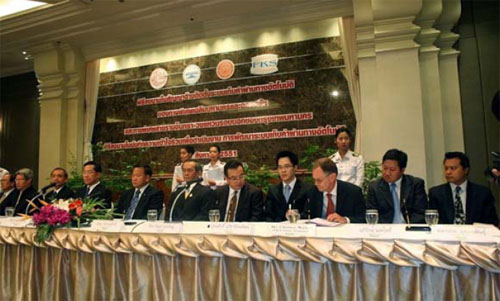
(Signing of contract – Christer Weiner, Kapsch TrafficCom Sweden, together with the Thai partners and customers)
As from autumn 2009, visitors to Bangkok will be escorted on their journey into the centre of the city by Austrian toll equipment. For Kapsch TrafficCom was able to notch up an order recently to fit out three large motorways in Bangkok. More specifically, the company will install the system by order of the Expressway & Rapid Transit Authority of Thailand (EXAT), in cooperation with the two Thai companies Fatima Group and Smart Traffic Co Ltd – as FKS Joint Venture. The Chalerm Maha Nakhon Expressway (consisting of three sections with a total length of 27.1 kilometres), the Chalong Rat Expressway (six-lane with a length of 18.7 km) and the Ramindra Outer Ring Project (with a total length of 9.5 kilometres) are set to be equipped with toll systems.
“Kapsch TrafficCom has repeatedly been successful in Asia. By replacing the 8-year old equipment and upgrading the electronic toll system, the flow of traffic on these three motorways will be sped up and traffic jams will to a large extent be avoided. This was possible primarily because of the extensive expertise of our employees and due to our many years of experience on the Asian market”, declares Erwin Toplak, Member of the Board, Kapsch TrafficCom AG.
The contract to set up the largest electronic toll system to date and a central system for registering and guiding traffic comprises altogether 80 lanes. The new infrastructure will include 100,000 CEN DSRC compatible transponders, 100,000 non-contact smart cards and other equipment (i.a. server equipment, a network and a CCTV video camera system). The system will be completed in autumn 2009 and comprises an order volume of approximately 8.5 million euros.
Kapsch TrafficCom is an international supplier of innovative road traffic telematics solutions. Its principle business is the development and supply of electronic toll collection (ETC) systems, in particular for the multi-lane free-flow (MLFF) of the traffic, and the technical and commercial operation of such systems. Kapsch TrafficCom also supplies traffic management systems, with a focus on road safety and traffic control, and electronic access systems and parking management. With more than 140 reference projects in 30 countries in Europe, Australia, Latin America, in the Asian/Pacific region and in South Africa, and with almost 12 million on-board units (OBUs) and nearly 11,000 equipped lanes, Kapsch TrafficCom has positioned itself among the leading suppliers of ETC systems worldwide. Kapsch TrafficCom is headquartered in Vienna, Austria, and has subsidiaries and representative offices in 20 countries.
For further information:
Brigitte Herdlicka
Public Relations & Sponsoring
Kapsch Group
Phone: +43 (0) 50 811 1705
A-1120 Vienna, Wagenseilgasse 1
E-mail: [email protected]
www.kapschtraffic.com
www.kapsch.net
ATTSII Recommends Guidelines For A Suitable Electronic Toll Collection Standardisation For India
July 31, 2008
PROPOSES WORLD WIDE TESTED AND RECOGNIZED CEN 278, BASED ON DSRC MICROWAVE TECHNLOGY
New Delhi, 23rd July, 2008: The Association of Toll and Traffic Systems Integrators of India (ATTSII) has recommended guidelines for a suitable Electronic Toll Collection (ETC) to the working group formed by the Committee of Road Safety and Traffic Management, Ministry of Surface Transport and Highways to determine the technology for Advance Traffic Management Systems, Advance Travel or Information Systems and Electronic Toll collection Systems. The association proposes CEN 278 standard based on DSRC (Dedicated Short Range Communication) microwave technology for the Indian subcontinent keeping in mind the Indian environment and driving conditions.
Representing the association, Mr. Sachin Bhatia, President ATTSII and Country Director of KAPSCH METRO JV said, “CEN 278 is the most acceptable technology worldwide with interoperability standards. It is already successfully implemented at the Delhi – Gurgaon Expressway, the largest 32 lane toll plaza in India. Introduction of smart tags based on microwave technology has received overwhelming response from drivers who earlier had to wait in long queues for several hours at the Toll. Now, it only takes few seconds for each vehicle to pass through, significantly reducing waiting time. CEN 278 is a cost effective technology as multiple vendors are present in the market to ensure that customers get the best competitive deal.
“At a time when India is starting to put in place the ETC technology, it should adopt the most advanced technology that is pre tested, allows wider applications and faster data transfer speed. We cannot afford to lose time in deciding on a technology as there is an urgent need to meet the ever increasing traffic management requirements in India that suits the masses and is most viable to implement,” said Mr. Aman Kishore ,VP of the ATTSII and Managing Director of International Road Dynamics (IRD) South Asia.
“IRD have successfully implemented CEN 278 standard microwave based Electronic Toll Collection(ETC) technology in April 2006 at Hoogly River Bridge Commissioners (HRBC) site at Vidyasagar Setu – Kolkata. HRBC is a West Bengal Government organization for operation, implementation and maintenance of Hoogly Bridge. Currently, it has 24 lanes at 1 Plaza with 4 ETC Lanes and is efficiently meeting requirements of the department to cater to heavy traffic volumes in a matter of seconds at the entry to Kolkata city,” added Mr. Kishore.
He further explained, “Most of the Build Operate Transfer (BOT) operators are opting for technology for ETC which is more cost effective and operationally efficient for Indian conditions. Recently, we have bagged an order for implementation of CEN 278 standard microwave based ETC from one of biggest BOT and O&M operators in the country – Ideal Road Builders (IRB), Mumbai for one of its locations at Mumbai’s Entry Points. The decision of opting for Microwave based ETC technology by such a reputed company must have been taken after much due diligence.”
“The major advantage of the microwave technology is the presence of numerous vendors in the market that generates fair competition. We must understand the emerging traffic volume in our country and we must opt and guide for technology which best meets diverse user needs and national interest, rather than being guided by commercial interest of vendors.
“CEN 278 standard is based on microwave technology, making it more reliable, robust and viable. A very recent example is the stormy morning of 14th May; any other known standards based on other technologies like infrared would have created chaos at points where it would have been applied. This is because in dusty weather, data fails to be securely transmitted, resulting in distortion in reporting and further leading to revenue leakages at tolling booths. As ATTSII represents the road operators in India, we sincerely hope to provide the best infrastructure and cost effective method of ETC for the end benefits for our people, we strongly recommend CEN 278 to be included as a policy due to its advantages outweighing that of any other present technology, pre -tested and widely accepted”, further explained Mr. Bhatia.
“It is a proven technology being used for electronic toll collection for many years around the world. This proves also our more than 140 reference projects in 30 countries in the Asian/Pacific region, Europe, Australia, Latin America and in South Africa. This technology guarantees thanks the reliability of the tolling system and the low error rate the maximum toll income and it is the perfect choice for charging on motorways, expressways and even secondary main roads. With respect to interoperability the DSRC is the only working technology today providing the necessary standards and specifications. We have also already made very good experiences with using of the DSRC tolling systems for the improving of the road safety and for the optimizing of the traffic flow by the installation of traffic data sensors or variable message signs on the toll gantries,” said Erwin Toplak, Management Board, Kapsch TrafficCom AG.
About ATTSII
The Association of Toll and Traffic Systems Integrators of India (ATTSII) has been established in India for the Toll and traffic Industry players to share their views; ideas and technologies through a common platform. The Association comprises of the leading players of the Industry as below:
- IRD, Canada / India
- Kapsch TrafficCom AG; Austria/ India
- GEA; France / India
- CS ROUTE ; France/ India
- Metro Road Systems ; India
- Q-Free / Comvision , India
About Kapsch TrafficCom AG
Kapsch TrafficCom AG is an international supplier of innovative road traffic telematics solutions. Its principle business is the development and supply of electronic toll collection (ETC) systems, in particular for the multi-lane free-flow (MLFF) of the traffic, and the technical and commercial operation of such systems. Kapsch TrafficCom also supplies traffic management systems, with a focus on road safety and traffic control, and electronic access systems and parking management. With more than 140 reference projects in 30 countries in Europe, Australia, Latin America, in the Asian/Pacific region and in South Africa, and with almost 12 million on-board units (OBUs) and nearly 11,000 equipped lanes, Kapsch TrafficCom has positioned itself among the leading suppliers of ETC systems worldwide. Kapsch TrafficCom is headquartered in Vienna, Austria, and has subsidiaries and representative offices in 20 countries.
For further media queries contact:
Alka Ohja / Archana Sharda
Blue Lotus PR
[email protected] / [email protected]
011-46571241 / 42
9958443490 / 9811838332
From April, pay toll tax to use NH 25
February 24, 2008
Lucknow, February 24 Planning to take the Lucknow-Kanpur highway? Get ready to pay for a smooth driving experience. The National Highway Authority of India (NHAI) is all set to introduce toll tax for the 48-km Lucknow-Unnao stretch on NH 25 by April this year. It will set up a toll tax booth just before Nawabganj.
NHAI officials said the recommendation in this regard has already been sent to the Ministry of Road, Transport and Highways and a notification is expected within a month.
The toll tax may be charged at reduced rates initially, they added.
“A toll plaza is generally set up at an interval of 70-80 km on the highway. But a railway overbridge in Unnao on Lucknow-Kanpur stretch is yet to be completed. So, the toll may be reduced proportionately,” said M K Jain, Project Director of NHAI.
The proposed site (near Nawabganj) for the toll plaza suggests that commuters coming from Lucknow to Unnao and Kanpur will have to pay the tax.
“Similarly, the people coming from Kanpur to Lucknow will also have to pay the toll. But, people travelling from Lucknow to Banthara or from Kanpur to Unnao would be saved from the tax,” an official said.
The proposed toll site, however, may be changed after the ROB in Unnao is completed.
While cars, jeeps and vans will have to pay a tax of around Rs 25, trucks and buses will be charged around Rs 95.
“The toll tax is calculated for 12 am to 11.59 pm for one-side trip. If a commuter has to return on the same day, he will have to shell out about one-and-a-half times of the toll rate,” a NHAI official said.
“For daily commuters, the NHAI can issue monthly passes,” he added.
According to NHAI norms, VIPs, defence vehicles, police vehicles, fire-fighting vehicles, ambulances, funeral vans, posts and telegraphs department vehicles will not have pay toll tax.
This will be the second highway after NH 2 in the state on which toll tax will be introduced.
“According to government policy, NHAI will set up toll plaza as soon a particular highway stretch is completed. And these are going to stay, so that NHAI could carry out maintenance and upgradation works effectively,” another official said.
Source: expressindia.com
